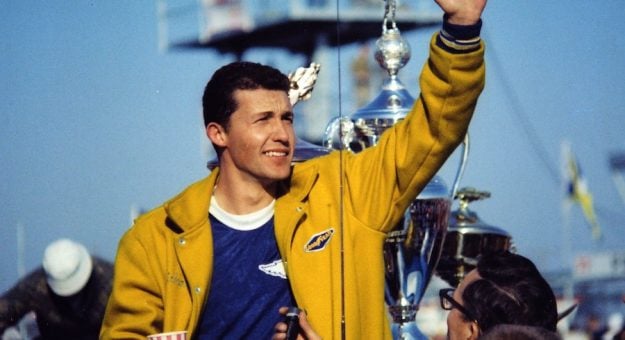INDIANAPOLIS — Sixty years ago this month, it all began to change for Richard Petty.
He pulled into Daytona Int’l Speedway as the most promising young driver in stock car racing. Three weeks later, he headed north with the Daytona 500 trophy — his first of seven — and a solid start on becoming the most important driver in NASCAR history, with a million-dollar smile, unmatched people skills and the kind of nickname that sticks in the brain: King Richard.
In February 1964, Petty was 26 years old. He had already won 28 times on what was then NASCAR’s Grand National circuit, a rock-’em, sock-’em tour that dragged Bill France’s foot-soldier teams to half-mile dirt tracks, asphalt bullrings, the occasional road course and superspeedways that were still works in progress. He’d been on the trail since 1958, first as understudy to his champion father, Lee Petty.
When a devastating wreck in the 1961 Daytona 500 derailed Lee’s career, Richard carried on the family business. In both 1962 and ’63, he finished second to Joe Weatherly in the standings.
He was already the perfect 1960s racer, equal parts speed, savvy and mechanical know-how.
But the biggest thing Petty had going for him in 1964 was Chrysler’s new engine, a 426-cubic-inch growler topped by cylinder heads with hemispherical combustion chambers; saving on syllables, the engineers called it a hemi. Chrysler had fiddled with hemis since the ’50s, particularly in drag racing. Working quietly across the summer and autumn of 1963, its dyno geeks set about building a Ford-killing NASCAR engine. They got it right.
An early version was shipped to Level Cross, N.C., where the men of Petty Enterprises shoehorned it into a Plymouth Belvedere. Befitting its secret-weapon status, Richard Petty first ran the hemi in cloak-and-dagger conditions at Goodyear Tire & Rubber Company’s five-mile oval in Texas. Petty knew he was onto something good when the big hemi sounded “like it was going to suck the hood in.”
As 1964 dawned, Chrysler shipped hemis to the Pettys and loyalist team owners Cotton Owens, Ray Fox and Ray Nichels. In February at Daytona, they made the factory Fords and Mercurys look like they were powered by hamsters. Paul Goldsmith put his Plymouth on the pole, and the twin 100-mile qualifying races fell to Junior Johnson and Bobby Isaac, both in Dodges.
Come the big Sunday show, the Daytona 500, Petty was in a league of his own. He started outside the front row, had his Plymouth’s blue nose out front on his second trip past the grandstands and led 184 of the 200 laps.
Not other driver went the full distance. Even with his own stout hemi, runner-up Jimmy Pardue finished a lap down.
With that, Petty was off and running. The 1964 series schedule included a record 62 races; he started 61 and finished in the top three 37 times, including nine wins. It was enough to earn him the first of his seven NASCAR championships.
And, of course, enough to prompt some long-forgotten newspaperman to label him King Richard.
Had his name been Earl Petty or Floyd Petty, or if he’d settled on Dick Petty, as the writers called him early on, he might never have gotten a nickname at all. But, in the formal southern tradition, the family called him Richard. History and literature were full of King Richards, and these press-box types loved to lean on clichés, so here came King Richard Petty, who has reigned in the hearts of NASCAR fans ever since.
We were talking one day about his enduring appeal. “Look, I came along at the right time,” he told me. “I’m not comparing myself to any of these people, but you can talk about Arnold Palmer, or about Babe Ruth or about George Washington, and you’re talking about someone who was the right person for the right time.”
As was Richard Petty. His emergence as a winning force coincided with NASCAR just starting to become something more than a blip on America’s sporting radar. The Daytona 500 and the Southern 500 at Darlington drew enormous crowds, and the whittled-down race highlights that popped up on ABC-TV’s “Wide World of Sports” boosted racing to new levels of coast-to-coast awareness.
Someone had to lead NASCAR into the bright lights, and, frankly, not many of its top racers were equipped for the job. Johnson had served federal time for operating an illegal whiskey still. Isaac, clearly a comer, had only a sixth-grade education and avoided interviews. LeeRoy Yarbrough, who in 1964 picked up his first two NASCAR premier series victories, was high-strung and ornery. Bobby Allison had the requisite talent and charisma, but was forever feuding with rival drivers, officials, even his own team owners. And David Pearson, on his way to becoming the rival Petty respected most, just didn’t give a hoot for celebrity.
Well, it just so happened that the million-dollar smile of young King Richard came wrapped in an aw-shucks Andy Griffith affability. Petty could charm sportswriters from far-flung outlets like the Detroit Free Press and the Los Angeles Times and say exactly the right thing for the TV audience. NASCAR couldn’t have hoped for a better ambassador; he didn’t chase the role, but it fit him just fine.
“That’s fate, OK?” said Richard Petty, the King. “I just happened to be here.”
Good thing for him, and for his sport.
You can find him this week at Daytona, where his legend sprouted all those years ago and where the winds still carry the echo of that hemi.
